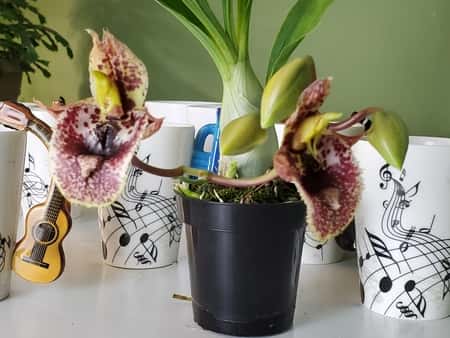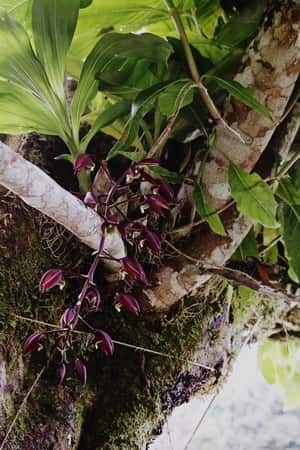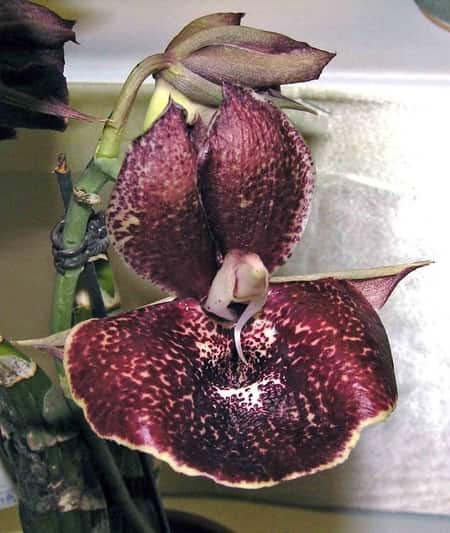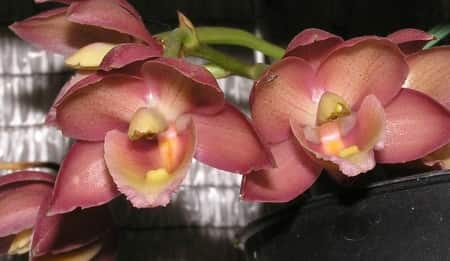Catasetum orchids are different than most commonly known orchids sold in the supermarket or grocery store. It isn’t surprising that even Darwin was fascinated by Catesetum, stating, “I have reserved for separate description one sub-family of the Vandeæ, namely the Catasetidæ, which may, I think, be considered as the most remarkable of all Orchids.” Charles Darwin, 1862.
Being deciduous perennials, Catasetum orchids will enter a severe period of dormancy, losing all its leaves and most of its roots. Watering is fundamental in this orchid’s life cycle since water will trigger or hinder its growth patterns. In this article, you’ll learn 9 concepts to master while watering your orchid.
When watering a Catasetum orchid, you’ll need to understand:
1. When to start watering your orchid After Dormancy
2. What’s the best type of water to use for a Catasetum (pH)?
3. How Much Water to give While breaking Dormancy
4. How Much Water to Give When in Full Growth
5. When to Slowly Stop Watering the Catasetum
6. When to Fully Stop Watering
7. How Long to Wait Before Watering Again?
8. Watering after Repotting Catasetum
9. Emergency Situations to Water in Dormancy

Before I explain each one of these situations one by one, it’s extremely vital to understand the way these fascinating Catasetum orchids live in nature and how they react to:
temperature,
humidity,
light,
and other environmental indicators.
Catasetum Orchids Growing in Their Natural Habitat
Catasetums are NOT found in tropical and subtropical rainforest, like most of the store-bought Phalaenopsis orchids we see in the supermarkets.
They are cultivated in hot, humid, lowland areas of plains and valleys all across the south of North America, Latin America, and the Northern/Central part of South America (from Mexico to South of Argentina), southern part of Africa, and Asia.
These areas all have in common hot, humid environments with plenty of rain during the summer, and a period of no rain, where the winters are dry and a tad bit cooler.
1.When to Start Watering Your Catasetum Orchid
Catasetum orchids will break dormancy when they sense a shift in humidity, temperature, and light. The food they had stored in their thick, massive pseudobulbs will now be nearing empty, and they should be somewhat shriveled.
If your pseudobulb is totally shriveled and looking sickly, please jump to the 9th point in this guide. In that particular case, your orchid may need water. But most Catasetum orchids will have done well during their growth months to produce huge, massive storage compartments (called pseudobulbs) and can survive through horrible droughts.
Video: When to Repot a Catasetum
https://www.youtube.com/embed/Sm7_8voAnrk The Catasetum orchid—or any orchid for that matter—would need a pretty thick pseudobulb to survive such harsh conditions on its own.
With not a drop of water for six months, the Catasetum orchid adapted, finding several ways to conserve energy. One of those ways was dropping its leaves. It there are no leaves, there is no energy being spent to maintain them and nurture them.
Every single leaf on the Catasetum orchid will fall off. It’s just dang ugly.
Horrendously ugly.

Depending on how long this drought season lasts, some Catasetum roots will start dropping off, too. Not all Catasetum orchids have the same dormancy cycle. Some will need one month; some stay dormant for five months. In either and all cases, they don’t need all those massive roots if the orchid is not absorbing water. There is no water to absorb. In a contingency plan to save energy at all costs, all the roots die off except a few.
When the orchid has been dormant for a few months and it senses the humidity changes, it knows it can start to produce new leaves. In Brasilia, you could smell the rain before it came down, hitting the pavement like hot tea.
The unique smell of hope after a long period of drought—it does something to your soul.
The Catasetum Orchid will start to produce new roots to prepare itself for this downpour of rain. DO NOT WATER YET! The first few roots are developing when the humidity is rising, not when it’s pouring down rain.
If you water when you notice the first signs of root growth, you’ll stunt the development and they won’t mature into their full potential. You’ll wrongfully trick the Catasetum into focusing on producing new leaves and a flower spike, when the root system is not yet developed.
When it starts to rain a month later, the roots will be mostly developed into their full potential, not growing much at all after that point.
This is so important to understand: the roots do not need to be watered at this point. They are perfectly fine since they are receiving nutrients from the pseudobulb, which should still be somewhat plump. Don’t water the orchid until the roots are 3 to 8 inches long.
Summarizing, when you see the first new roots tips (normally around spring), it’s a sign to repot but NOT WATER. Don’t ever water at this initial sign of growth. You can start watering in about three to six weeks after the new roots appear, when they are long enough to support the plant when there is no more in supply from the pseudobulb.
2. What’s the best type of water to use for a Catasetum?
In terms of pH, it’s best to aim for water that is near neutral or a little below. Anywhere from 5.5 to 6.5 on the pH scale is best for Catasetum. Even though there are some Catasetum that are terrestrial and those will specifically prefer a higher pH, most other Catasetum orchids are epiphytes are will prefer more acidic water closer to 6.0.
As long as you are using good quality water (by this I mean reverse osmosis water, rainwater, well water, or distilled water) and not tap water with high chlorine concentration in the solution, your Catasetum will be fine.
Tap water tends to be extremely high in pH, which does nothing for the plant. To reduce the amounts of trace elements in the water, soft water uses a high concentration of sodium. This will cause mineral build-up in the plant and salt deposits which burn the roots.
If you can’t get access to rain or well water, prefer tap over soft water. The chlorine count will do less harm than the high salt will. If this short description still left some explanation to be desired, check out this article about water quality for orchids, which is a lot more extensive.
3. How Much Water to give While breaking Dormancy
Once the new Catasetum roots are more than 3 inches long, (preferably around 8 inches or 20 cm) and new leaves are forming, then it is time to water. This should coincide with spring in for many Catasetum orchids. When the orchid breaks dormancy, you can start watering like you would a Phalaenopsis orchid. Always make sure the potting medium is moist, a little more so than the Phal. If your potting medium becomes dry, you risk harming the orchid.
You should also resume fertilization during this period. If your Catasetum orchid is in moss, this article about fertilizing orchids in sphagnum moss gives good details on how not to over fertilize. Most growers use slow release pellets, but I haven’t tried that method before with Catasetum orchids. If your lost in the fertilization department, try this article which explains the different kinds of methods to fertilize orchids.
Once a few new leaves appear, increase watering little by little. The new roots aren’t accustomed to absorbing water and if you provide too much, they can become stressed. Whatever they don’t initially absorb, will hinder gas exchange later on.
It is crucial to providing the most amount of water to your orchid as possible. In the next few months, your Catasetum orchid will spring to life with new leaf, after new leaf, after new leaf. New pseudobulbs form. New life pops up out of nowhere and in a few months, it is a whole different plant. This requires tons of water and fertilizer, which brings us to the next step.
4. How Much Water to Give a Catasetum When in Full Growth
Soak your orchid and soak it some more. Drench it until you think it’s drowning then have no mercy and waterlog it again. Increase watering almost up to every other day, if need be. This will depend a lot on your growing conditions.

Don’t worry about root rot.
As long as you have a good potting soil for Catasetums that retain water and provide adequate drainage, your orchid should be fine. Some growers include a reservoir of water at the bottom of the base of Catasetums, just to provide more access to water if the orchid should want it.
All those months in dormancy will make the orchid overly thirsty. It’s almost impossible to get root rot with a Catasetum during this phase because the root you hadn’t watered in those first weeks will now absorb everything they can get a hold of.
Water. Water. Water.
5. When to Slowly Stop Watering the Catasetum
Catasetums will produce flowers that in bloom last for three to four weeks. Once they wither and fall off, the bottom leaves yellow. Slowly reduce watering back to what would be similar to a Phalaenopsis cycle.
The orchid has developed full pseudobulbs and has finished its course in nature for this cycle, requiring no more energy. It will slowly yellow and wither until all leaves drop. This should coincide with late autumn for most Catasetum.
Follow the Catasetum’s cues on yellowing—the more it yellows then turns brown, the less you water. Hold back on fertilizing also.
When I lived overseas in Brazil, I used to joke that we did not have 4 seasons, but two: a dry season and a rainy season. For six months straight, it rained every single day, with thunderstorms, lightning, and water flooded came down as if it would never end. For the next six months, we went into dry season, and didn’t see a drop of rain.
Humidity levels dropped lower than the Sahara Desert. It was so low that the government canceled school some days. In Kansas we have snow days; in Brazil we have low-humidity days.
What amazes me is I never understood how orchids survived this type of climate. Yet, they did and were extremely gorgeous year after year. All I had to do was admire them, and nature did the rest.
It was only after I returned home and started growing orchids in my home office in Kansas that I had to research to see the reasons and understand why orchids behaved the way they did. I said all that to say, “It’s ok to hold back on watering. They’ll live. Trust me.”
6. When to Fully Stop Watering
Once the last leaf has fallen off, halt watering altogether. For most Catasetum orchids, this season will coincide with December or early winter. I know this seems heartless and evil, but this is what nature does. You will need to mimic that same cycle in nature.
Some orchid growers go to the extreme of removing all potting medium and exposing the roots to bare air, but I find that extreme. It won’t hurt the plant by any means, but I just feel it exposes the plant.
The roots will die off. This is part of nature’s way of conserving energy for the next cycle. Don’t worry about unpotting it if you’d like, just don’t repot it quite yet. More on that below.
You can place the Catasetum in a dark corner of the garage and forget about it for a few months. I have read about this being done, but I don’t because I tend to forget it for too long. Years later I find a dead root ball to a once healthy Catasetum that cost me a fortune. Out of sight, out of mind… So I keep my dead-looking plant near me, just on a lower shelf and just hide it from visitors and friends.
If you happen to water during this period, the water will not be absorbed by the roots. This is where the majority of the root rot occur when growing Catasetums.
Not knowing that Catasetums will not absorb any of the water provided, a new grower might be tempted to water the plant after a few weeks of dormancy. The water sits in the pot and isn’t absorbed by the orchid.
There is minimal gas exchange or any activity of any kind, perfect for spider mites and fungus. Spider mites are drawn to this orchid because of the low humidity. To rid them from your plant, follow this article that talks specifically about insects and other pests that can be found in sphagnum moss. In summary, raising humidity (not water but humidity, which are two very different things) the spider mites will disappear.
7. How Long to Wait Before Watering Again?
When new leaves appear, resume watering.
This is where we complete the full circle and can start reading from the first point. In a couple of months, depending on the Catasetum up to five but can be less, new roots will appear. Just when you think the orchid should be thrown in the trash, new roots appear.


8. Watering after Repotting Catasetum
Watering and repotting are two very distinct stages for a Catasetum orchid. Usually I water after every repotting, but with Catasetums, this cannot be so. You should repot when you see the first signs of new roots. If they grow too much into the potting medium, you have waited too long to repot and can damage the only new source of life for the plant.
Those tender new roots are fragile and sensitive. This is why you need to provide fresh media every year and do it before they reach the old media. It is instinctive to water after you repot, but for the love of everything you hold dear, don’t water.
Wait until the roots have penetrated the medium and are strong, healthy, large, plump roots. Don’t fear of withholding too long. The pseudobulb is nowhere near depleted and will provide for the root’s maintenance.
9. Emergency Situations to Water in Dormancy
There are a few exceptions to the rules above. If your orchid has a pseudobulb that is overly wrinkled and looking sick, water. It has used up all the energy that it had in storage and needs a new source of life. This should not happen since Catasetum roots are like potatoes or yams. They are hardly capable of becoming dried up completely, but you never know what happened during dormancy.
Maybe an insect found good nutrients and a vast supply of food for a couple of months in the pseudobulb, chewing away from the inside.
Maybe the orchid was sick before dormancy and withered from the inside out.
Many things could have happened to cause for a withering Catasetum pseudobulb, so if this is your case, water. There is not much else you can do. Water will give the orchid a boost until it makes it until spring, yet there are no guarantees.
Another occasion that you should initiate watering before the roots are long and full is when you see a root withering. The roots should be plump and firm at all times, and signs of problematic roots signal insufficient nutrients from the pseudobulb.
If you can water the longer roots at the end of the vase or orchid pot without watering the whole plant (eyedropper, syringe, or any other device applied in a hole in the bottom of the pot) this could still provide some water for the plant, while not yet setting off the alarm to halt all root growth. With these 9 concepts of watering Catasetum orchids, you’ll be well on your way to a full, beautiful orchid that produces amazing flowers. Fingers crossed that the flowers will be male, and not hooded, indistinguishable green female flowers, but that’s information for another article.
Don’t Stop Learning!
If you want to be included in more information and get a 14-page fertilization guide, please sign up for my newsletter. I don’t spam, but send emails out bi-monthly with some curious topics of interest. If you want more information, click here to go to a specific page on this website where I explain it more in detail.

Also, if you are looking for an orchid journal to keep your notes specifically about orchid care, check out my 2 solutions for that on this page. If note-keeping isn’t your thing, then there is a free excel spreadsheet that you can download. Click here for more information on how to do that.
If you subscribe to my newsletter, I will send you a 14-page guide on the main tips of orchid fertilizer. It is downloadable and you can print it out on your computer. I designed the guide to double up as a coloring book, just to make it fun.
Further Reading Suggestions:
Don’t just take my word for what is written here. Continue researching other articles about watering Catasetum orchids, because everyone has a different point of view and unique techniques that work for them. Here are a few articles from other websites if you’d like to continue your research on Catasetum Orchids:
-This one-page printable culture sheet for the Catasetum orchid can be found on the American Orchid Society.
can be found on the American Orchid Society.
-Darwin’s bee-trap: The kinetics of Catasetum, a new world orchid. Written by Charles C Nicholson and published on Europe PMC Website and also in the journal Plant Signaling & Behavior is an interesting article about how the pollination of Catasetum orchids works. The way the male flower projects the pollina onto the back of the bee with incredible force is pretty amazing to read.
-Non-functional flowers in Catasetum orchids (Catasetinae, Orchidaceae) written by Gustavo A. Romero and published in the Botanical Journal of the Linnean Society, talks about the distinct male and female flowers in Catasetum orchids. They are quite different and this article explains in great detail.
written by Gustavo A. Romero and published in the Botanical Journal of the Linnean Society, talks about the distinct male and female flowers in Catasetum orchids. They are quite different and this article explains in great detail.
Happy Cultivating!


I am so glad I found this article/info on growing Catacetums. I was not sure when and how to water, read here and there a bit but need to learn more. Thank you for summarizing the care of these orchids.
I have 2 I bought last year ,one is coming out of dormancy and one is not. Just bought a small one potted in sphagnum, also coming out of dormancy. Do they have to be repotted now/ not so sure about that.